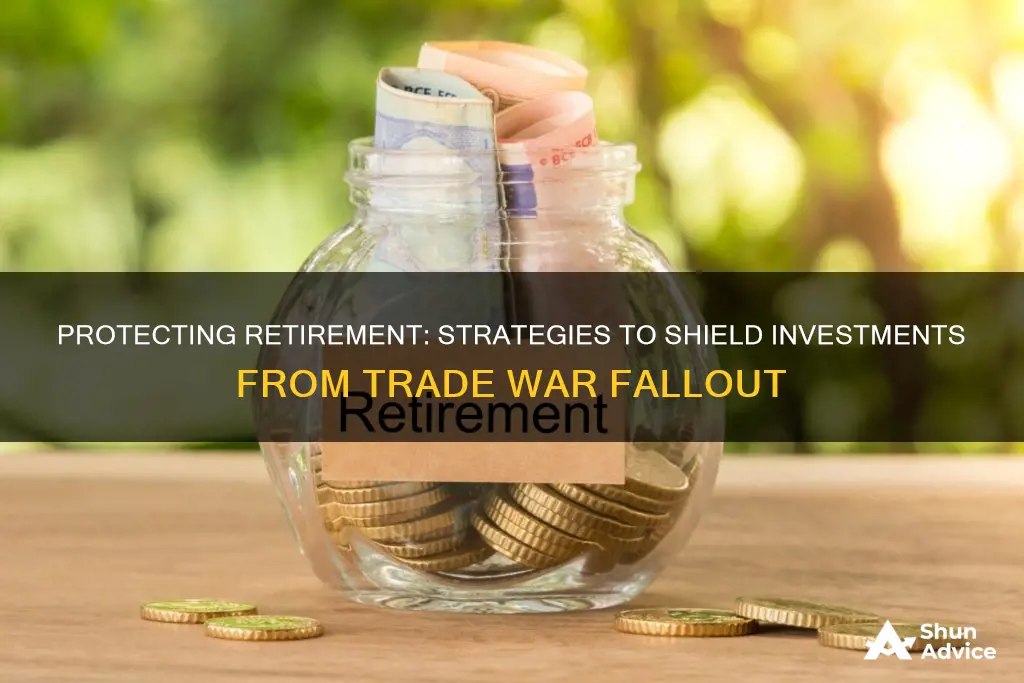
Protecting your retirement investments from the effects of a trade war is challenging, as almost all securities will be affected, directly or indirectly. While it may be too late to avoid the impact of a trade war, there are some strategies to shield your money.
Firstly, investors should ensure their portfolio allocation aligns with their risk appetite. If a position has grown to a larger percentage of the portfolio than intended, it may be wise to trim it back. Secondly, investors can look for buying opportunities in sectors that remain relatively undervalued, such as real estate and healthcare.
Thirdly, investing in companies with domestic supply chains can provide some insulation from increased costs due to tariffs. Additionally, focusing on growth opportunities within the domestic market may be prudent, although investors should be cautious as increasing prices may lead to a decline in sales and subsequent layoffs.
Finally, maintaining a well-diversified portfolio is crucial. This involves spreading investments across various asset classes, such as stocks, bonds, and cash equivalents, and regularly rebalancing to maintain the desired asset allocation.
| Characteristics | Values |
|---|---|
| Portfolio Mix | Diversify your portfolio, shift to more conservative investments as you get older |
| Emotions | Don't let emotions take over, stick to your long-term plan |
| Cash on Hand | Keep up to five years' worth of expenses in cash or cash equivalents |
| Withdrawals | Be disciplined about withdrawals, withdraw no more than 3% to 5% of your funds in year one of retirement |
| Investments | Look at the commodity or good you want to invest in closely, exercise caution with multinational corporations, focus on growth opportunities domestically |
What You'll Learn

Maintain a well-diversified portfolio
Maintaining a well-diversified portfolio is a crucial step in protecting your retirement investments from the impact of a trade war. Here are some detailed strategies to achieve this:
Diversify Across Asset Classes:
Diversification is a key principle in long-term investing. It involves spreading your investments across various asset classes, such as stocks, bonds, cash equivalents, and real estate. By diversifying, you reduce the risk of your portfolio being heavily impacted by any single asset class.
For example, consider having a mix of stock funds, bond funds, and investments in real estate. This way, even if one asset class performs poorly due to the trade war, the overall impact on your portfolio will be mitigated.
Regularly Rebalance Your Portfolio:
Over time, different asset classes will grow or decline at different rates. Therefore, it's important to periodically rebalance your portfolio to maintain your desired asset allocation. For instance, if your original portfolio allocation was 60% stocks and 40% bonds, but due to market gains, stocks now comprise 65% of your portfolio, you should consider selling some stocks and buying bonds to return to your target allocation.
Diversify Within Each Asset Category:
Diversification can also be achieved within each asset category. For example, if a large portion of your portfolio is dedicated to stocks, ensure a balance between large-cap and small-cap stocks and between growth and value funds. Additionally, consider having some exposure to international funds, as they can provide a cushion during a domestic economic slump.
Be Strategic with Bonds:
Not all bonds are created equal. High-grade bonds are often a better choice than junk bonds, which are more closely correlated to stock market performance. High-grade bonds act as a better counterweight to the stocks in your portfolio.
Maintain a Mix of Defensive and Growth Stocks:
During uncertain times, it's a good idea to invest in defensive stocks, which tend to perform well during economic downturns. These include sectors such as consumer staples, healthcare, and utilities. At the same time, maintain some growth stocks to take advantage of potential market upturns.
Opt for Low-Cost Index Funds:
During volatile times, consider investing in low-cost index funds. These funds track a specific market index, such as the S&P 500, and are designed to be more stable and less risky than actively managed funds.
Focus on Domestic Growth Opportunities:
In the face of a trade war, consider investing in companies that generate revenue through a domestic supply chain. This way, their business is partially insulated from the direct impact of tariffs and trade tensions.
Remember, maintaining a well-diversified portfolio is a dynamic process that requires regular monitoring and rebalancing. It's also essential to seek advice from a financial advisor to ensure that your investment strategies align with your specific retirement goals and risk tolerance.
Loan Payments: Financing or Investing?
You may want to see also

Focus on growth opportunities domestically
Focusing on growth opportunities domestically is a vital aspect of safeguarding retirement investments amid a trade war. Here are some detailed instructions and considerations to help guide your investment strategy:
Diversify Your Portfolio
Diversification is a crucial aspect of investment management, and it becomes even more important during uncertain times. Diversification helps to spread risk and potentially mitigate losses. When focusing on domestic growth opportunities, consider a range of investment options across various sectors and asset classes. This can include a mix of stocks, bonds, real estate, and commodities.
For example, you can invest in large-cap and small-cap stocks, growth and value funds, and explore sectors such as healthcare and real estate, which tend to be less volatile and provide stable growth opportunities.
Take Advantage of Domestic Market Knowledge
Investing domestically allows you to leverage your knowledge of the local market and economy. You can make more informed decisions by understanding the cultural, political, and economic landscape of your own country. Keep yourself updated on the latest industry trends, regulatory changes, and market movements. This can help you identify sectors and industries that are poised for growth and make strategic investments accordingly.
Long-Term Investment Perspective
When focusing on domestic growth opportunities, it is essential to adopt a long-term investment perspective. Domestic investments can be less susceptible to the direct impact of a trade war, and by taking a long-term view, you can ride out short-term market volatility.
Review your investment portfolio regularly and make adjustments as necessary to align with your long-term goals. Remember that market downturns can also present buying opportunities, allowing you to acquire assets at lower prices.
Maintain Discipline and Avoid Emotional Decisions
It is crucial to maintain discipline and avoid making impulsive decisions based on emotions. Trade wars can create uncertainty and anxiety, but it is important to stick to your long-term investment plan. Avoid the urge to sell off investments prematurely or make drastic changes to your portfolio based on short-term market movements.
Instead, focus on your investment objectives, risk tolerance, and time horizon. Consult with a financial advisor or planner to ensure your investment strategy is tailored to your specific circumstances and goals.
Rebalance Your Portfolio Regularly
As you approach retirement, regularly review and rebalance your portfolio to ensure it aligns with your risk tolerance and investment goals. As you get older, gradually shift your portfolio towards more conservative investments that can better withstand market downturns. This is a natural part of the investment journey, and it helps to ensure your portfolio remains aligned with your life stage and financial objectives.
In summary, focusing on domestic growth opportunities involves diversifying your portfolio across various sectors and asset classes, leveraging your knowledge of the local market, adopting a long-term investment perspective, maintaining discipline, and regularly rebalancing your portfolio as you approach retirement. Remember to seek professional advice and ensure your investment decisions are well-informed and aligned with your financial goals.
Military Personnel: Investing for the Future
You may want to see also

Keep cash on hand
Keeping cash on hand is a key strategy for protecting your retirement investments, especially in volatile economic climates. Here are some detailed tips on how to do this effectively:
Firstly, it is recommended to have an emergency fund that covers three to six months' worth of living expenses. This buffer will prevent you from dipping into your retirement savings and incurring early withdrawal penalties. Some experts even suggest keeping enough cash to cover six to twelve months, or even up to three years' worth of daily living expenses. This emergency fund should be easily accessible and kept in an account that won't lose value, such as an FDIC-insured bank account.
If your savings exceed the FDIC insurance limit of $250,000, consider opening another savings account at a different FDIC-insured bank. You could also explore other savings vehicles that offer higher returns, such as money market accounts or certificates of deposit (CDs). However, be cautious of high fees associated with some money market accounts, and be aware that accessing funds from a CD is not always easy.
While it's important to keep some cash at home for immediate needs, avoid keeping large amounts of cash outside of secure accounts. Instead, focus on maintaining a disciplined withdrawal plan and don't let emotions cloud your judgment. It's crucial to stick to your long-term investment strategy and make adjustments based on your financial goals, rather than reacting to short-term market fluctuations.
Additionally, consider keeping some of your "cash equivalents" in the form of Treasury Inflation-Protected Securities (TIPS). These securities have a fixed interest rate, but their par value increases with the Consumer Price Index, protecting your purchasing power during inflationary periods. However, remember that if you buy TIPS at a premium and a period of deflation occurs, future inflation adjustments could be negative.
In summary, keeping a substantial emergency fund in accessible and stable accounts is a crucial part of protecting your retirement investments. Combine this strategy with a disciplined approach to withdrawals, and you'll be better equipped to weather economic uncertainties and market downturns.
Lucrative Options: Exploring 5% Returns on Investments
You may want to see also

Be disciplined about withdrawals
When it comes to your retirement investments, being disciplined about withdrawals is key. Here are some detailed tips to help you protect your savings:
Understand the rules and strategies for withdrawals
Before you start withdrawing from your retirement accounts, it's important to understand the rules and strategies involved. Each type of retirement account has its own withdrawal rules and age requirements. For example, with a traditional IRA or 401(k), you can generally start making penalty-free withdrawals at age 59 1/2. However, if you withdraw early, you'll typically incur a 10% early withdrawal tax penalty. On the other hand, Roth IRAs do not require withdrawals until the owner of the account dies, and there are no required minimum distributions (RMDs). Knowing these rules will help you make informed decisions about when and how much to withdraw.
The 4% rule
One popular withdrawal strategy is the 4% rule, which suggests withdrawing 4% of your retirement savings in your first year of retirement and then adjusting that amount for inflation in subsequent years. For example, if you have $1 million saved, you would withdraw $40,000 in the first year and then increase that amount by 2% in the second year to $40,800. This approach offers a predictable income stream, but it has been criticised for not adequately addressing rising interest rates and market volatility.
Fixed-dollar withdrawals
With fixed-dollar withdrawals, you take out the same amount of money from your retirement account every year for a set period. For instance, you might decide to withdraw $20,000 annually for the first five years of retirement and then reassess. This approach provides predictable income, making budgeting easier. However, it doesn't account for inflation, and if your fixed-dollar amount is too high, you risk depleting your savings prematurely.
Fixed-percentage withdrawals
Fixed-percentage withdrawals involve taking out a set percentage of your portfolio every year. For example, if you have a $1 million portfolio, you might decide to withdraw 4%, giving you $40,000 to spend for the year. This approach is simple and adjusts your withdrawals based on the performance of your investments. However, it can create uncertainty, and if the percentage is too high, you risk running out of money.
Systematic withdrawals
With systematic withdrawals, you only touch the income generated by your investments, such as dividends or interest, leaving your principal intact. This method ensures you don't deplete your retirement savings and gives your investments the potential to grow over time. However, your income may vary depending on market performance, and there is a risk that your withdrawals won't keep up with inflation.
The "buckets" strategy
The "buckets" strategy involves having three separate sources of retirement income: a savings account with three to five years' worth of living expenses in cash, fixed-income securities, and the rest of your investments in equities. You first draw from the savings account and then replenish it with money from the other two sources. This approach gives you more control over when you sell investments and allows your savings to continue growing. However, it can be time-consuming and still requires another method to determine your annual spending limit.
Consult a financial professional
Withdrawing money from your retirement accounts is a complex process that should be approached with discipline and careful consideration. Consult a financial or tax professional to determine the best course of action for your specific circumstances. They can help you navigate the rules, strategies, and tax implications to ensure you make the most of your retirement savings.
Paycheck to Paycheck: Strategies for Investing on a Tight Budget
You may want to see also

Be flexible with withdrawals
Being flexible with withdrawals from your retirement account is a good strategy to protect your investments during a trade war. Here are some detailed tips on how to do this:
Understand the Rules and Regulations
Before making any decisions, it's important to understand the rules and regulations surrounding retirement accounts and withdrawals. For example, in the US, there are mandatory distributions called RMDs (Required Minimum Distributions) that apply to certain types of retirement accounts, such as traditional IRAs and 401(k)s, once you reach a certain age (typically 73). Failing to take RMDs can result in significant tax penalties. Additionally, withdrawals from retirement accounts before the age of 59 1/2 are generally subject to a 10% penalty, as well as income taxes. Understanding these rules will help you make informed decisions about when and how much to withdraw.
The 4% Rule
One popular strategy for retirement withdrawals is the 4% rule. This involves withdrawing 4% of your investment account balance in the first year of retirement and then adjusting that amount annually to keep pace with inflation. For example, if you have $500,000 saved for retirement, you would withdraw $20,000 in the first year. If inflation is 2% in the following year, you would increase your withdrawal to $20,400. The benefit of this approach is its simplicity, and it ensures your purchasing power remains constant relative to inflation. However, with rising interest rates and market volatility, there is a risk of outliving your savings using this method.
Fixed-Dollar Withdrawals
Fixed-dollar withdrawals involve taking the same amount of money from your retirement account every year for a set period. This approach provides a predictable income, allowing you to create a budget for your retirement years. However, the main downside is that it does not account for inflation, which can erode your purchasing power over time. Additionally, setting a fixed-dollar amount too high may lead to depleting your retirement savings prematurely.
Fixed-Percentage Withdrawals
With fixed-percentage withdrawals, you withdraw a set percentage of your account balance each year. For example, you may choose to withdraw 3.5% or 4% of your total invested funds annually. This approach has the advantage of automatically adjusting your withdrawals in response to market fluctuations. However, choosing too large a percentage may result in outliving your savings. Additionally, as your income varies from year to year, financial planning can become challenging.
Systematic Withdrawals
Systematic withdrawals involve leaving your principal invested throughout retirement and only withdrawing the income generated from interest or dividends. This method ensures you cannot deplete your retirement account balance. However, it requires a large nest egg to provide sufficient income to cover your living expenses. As with fixed-percentage withdrawals, your income may vary year to year, making financial planning difficult. Additionally, if your investment gains do not keep up with inflation, your purchasing power may decline over time.
Work with a Professional
Consulting a financial advisor or tax professional is crucial when making decisions about your retirement withdrawals. They can help you navigate the complex world of taxes, investment strategies, and regulatory requirements. They can also provide personalised advice based on your unique circumstances, goals, and risk tolerance.
Your Investment Mix: Balancing Risk and Reward
You may want to see also







